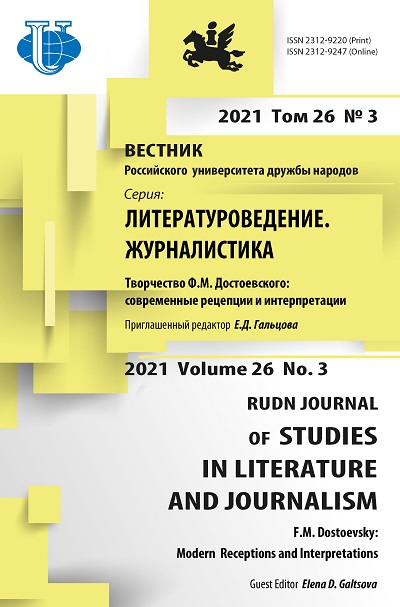Positivism in the Mirror of Carnival: The Rabelaisian Chronotope in the Works of E. Zola
- Authors: Albrekht O.V.1
-
Affiliations:
- Maxim Gorky Institute of Literature and Creative Writing
- Issue: Vol 26, No 3 (2021): F.M. DOSTOEVSKY: MODERN RECEPTIONS AND INTERPRETATIONS
- Pages: 519-528
- Section: LITERARY CRITICISM
- URL: https://journals.rudn.ru/literary-criticism/article/view/27653
- DOI: https://doi.org/10.22363/2312-9220-2021-26-3-519-528
- ID: 27653
Cite item
Full Text
Abstract
This paper deals with using the Rabelaisian “cultural code”, which the author of the article suggests to be applied to the reading and interpreting of some novels by E. Zola. From the author’s point of view, such an experiment allows us to look at French naturalism from a new point of view, as a variant of a typologically recurring phenomenon in the history of literature. For the French naturalistic novel Rabelaisianism is considered as a kind of meaning-generating model, as “appropriated communication” or as an element of traditional literary discourse. The latter is actualized in a period when the cultural conditions and the nature of the main ideological and aesthetic conflicts became similar to the time of the French Renaissance. The author attempts to apply the theory of the “carnival chronotope”, which is developed by M.M. Bakhtin, to the interpretation of some of E. Zola’s texts. Meanwhile, the concept of the chronotope is considered more widely than that of M.M. Bakhtin: it is proposed to understand the chronotope as a universal model of space-time relations in the novel. The author also views the poetics of the “real” in the naturalistic novel through the prism of the carnival (i. e. extremely detailed material world); as examples, the motives of food and wine, as well as the motive of rebellion and war as a variant of the “war for food” and the carnival battle of Shrovetide (pancake week) and Lent are analyzed in the article. The main material used for the analysis is taken from the novels Le Ventre de Paris , 1873 ( The Belly of Paris ), L’Assommoir , 1877 ( The Trap ), and Germinal , 1885, by E. Zola.
Keywords
About the authors
Olga V. Albrekht
Maxim Gorky Institute of Literature and Creative Writing
Author for correspondence.
Email: ars-kos@yandex.ru
ORCID iD: 0000-0002-9359-8237
Post-graduate Student of the Department of Foreign Literature of the Maxim Gorky Institute of Literature and Creative Writing; Senior Lecturer of the Department of Slavic Philology of the Orthodox St. Tikhon’s University
25 Tverskoy Boulevard, Moscow, 123104, Russian FederationReferences
- Smirnov, I.P. (1995). Generation of intertext. Elements of intertextual analysis with examples from the work of B.L. Pasternak. Saint Petersburg: Iazykovoi tsentr filologicheskogo fakul’teta SPbGU Publ. (In Russ.)
- Barthes, R. (1970). Le mythe, aujourd’hui. In R. Barthes, Mythologies (pр. 191–247). Ed. du Seuil.
- Bakhtin, M.M. (2012). Forms of time and chronotope in the novel. In M.M. Bakhtin, Collected works (Vol. 3. The theory of the novel, pp. 340–511). Moscow: Iazyki slavianskikh kul’tur Publ. (In Russ.)
- Zola, E. (1966). From the collection “The experimental novel”. In E. Zola, Collected papers in 26 vols. (Vol. 24, pp. 321–410). Moscow: Khudozhestvennaia Literatura Publ. (In Russ.)
- Barthes, R. (1994). The Effect of Reality. In R. Barthes. Selected Works. Semiotics. Poetics (pp. 392–400), Moscow: Progres Publ. (In Russ.)
- Zenkin, S. (2018). The theory of literature. Problems and results. Moscow: Novoe litera-turnoe obozrenie Publ. (In Russ.).
- Bakhtin, M.M. (2015). The work of Francois Rabelais and folk culture of the Middle Ages and Renaissance, Moscow: Eksmo Publ. (In Russ.)
- Barthes, R. (1985). Semioligie et urbanisme. In R. Barthes, L’aventure sémiologique (pр. 261–271). Ed. du Seuil.
- Silant’ieva, O.Iu. The Country of Kokan and Schlaraffia in French and German literature of the XVIII–XIX centuries (Dissertation of the Doctor of the Phylological Sciences). Moscow, 2006. (In Russ.)
- Scarpa, M. (2000). Le Carnival des Halles: Une ethnocritique du « Ventre du Paris » de Zola. Paris.
- Zola, E. (1967). Le ventre de Paris (the comments). In E. Zola, Oeuvres complètes (Vol. 2, pp. 561–821). Paris: Cercle du livre précieux.
- Larousse, petit dictionnaire de Français (2006). Рaris.
Supplementary files















